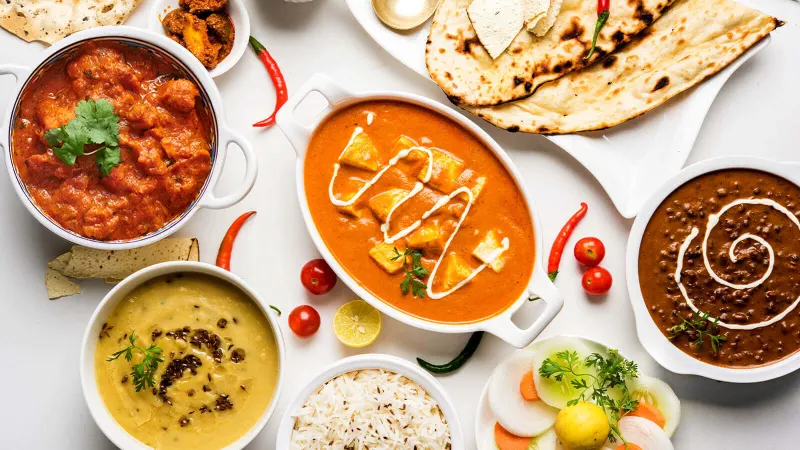The Heart of Indian Cuisine: Why Food Lovers are Drawn to Its Diversity
Indian cuisine features a rich combination of flavours and aromatic traditions, which enchant people from all over the world who enjoy food. The appeal of Indian cuisine exists in its exceptional range because it grew through extended cultural mixing and local community differences alongside everlasting culinary devotion. The lives of food enthusiasts and casual diners are drawn to Indian cuisine because of the specific characteristics we will analyse together.
A Symphony of Spices: The Soul of Indian Cooking
The fundamental essence of Indian cooking depends on perfect spice management. Spices use cumin along with coriander and chilli heat and cinnamon sweetness to deliver flavours beyond basic enhancement. They represent the great culinary tapestry that tells the story of Indian history. The culinary arts of each regional area develop their spice combinations, which produce specific traditional dishes that are both unique and highly gratifying.

Regional Delights: A Culinary Journey Across India
The extensive territorial dimensions of India support multiple culinary traditions with distinct characteristics across different regions of the country:
• North India: The traditional Indian cuisine includes creamy curries together with tandoori meats and rich bread options that extend to naan and paratha. People typically enjoy butter chicken and paneer tikka as traditional dishes of this cuisine.
• South India: Features rice-based dishes, tangy tamarind flavours, and coconut-infused curries. Idli, dosa, and sambar are everyday favourites.
• East India: Celebrated for its sweets like rasgulla and sandesh, along with mustard-flavored fish curries.
• West India: With meals like dhokla, pav bhaji, and Goan seafood curries, it provides a blend of spicy and sweet tastes.
Indian cuisine contains infinite appeal since regional diversity provides food options for every taste preference.
Vegetarian Paradise: A Haven for Plant-Based Eaters
The traditional eating habits in India began with vegetarianism because of both religious customs and societal beliefs. The active trade of vegetarian food choices across the country has produced an extensive range of nutrient-rich food recipes with outstanding flavours. Indian cuisine offers diverse vegetarian options which include lentil-based dals together with vegetable curries and paneer preparations that satisfy both vegetarians and people who eat meat.
The Art of Balance: Harmonizing Flavors and Textures
The Indian traditional culinary art shows exceptional talent in creating balanced dishes that contain all six fundamental tastes: sweet, sour, salt and bitter and pungent and astringent. Same as other Indian culinary approaches, the usage of balance enables chefs to produce satisfying flavours that combine both deliciousness and profound harmonisation. The dining experience grows more flavorful when one includes pickles with chutneys and raitas as supplementary items.
Celebratory Feasts: Food as a Cultural Expression
In India, eating serves both sacred and lucrative purposes for major events and spiritual occasions. Diwali, together with Eid and Pongal, commemorate special dishes that express both regional heritage and cultural traditions. Indian festivities guide the preparation of exclusive foods, which extend through family bonds as part of sharing traditions with loved ones.
Global Appeal: Indian Cuisine Around the World
The worldwide love for Indian food proves itself through the increasing number of Indian restaurants that have spread across international territories. The marriage of local tastes with rich food flavours makes Indian cuisine a common choice that appeals to multinational populations. People worldwide enjoy Indian cuisine because they discover a deep love for Indian dishes, whether they feast on curries in London or savour the spicy biryani in Melbourne.
Street Food Wonders: A Flavorful Experience Like No Other
Indian cuisine showcases its street food culture as one of its extremely compelling features. Indian street food can be encountered across the whole country, including city markets and village lanes where people find these edibles that deliver sensory delights of taste alongside colour and texture. The flavorful street food items such as chaat and samosas, along with pani puri and kebabs, are both budget-friendly options. Short-serving dishes at street stands reflect traditional recipes and regional product preferences that have been handed down through the years. Food enthusiasts find Indian street food experiences to be a place where they can directly encounter the essence of the nation's traditional cooking methods.
Conclusion
Everyone who enjoys food discovers happiness through Indian cuisine since it presents a sequence of flavours and cultural elements. Each person can find delightful dining options in Indian cuisine with its spicy street snacks and curries alongside comfort foods prepared in homes. The diverse selection of authentic Indian meals at Priya Indian Cuisine presents the rich traditions of this cuisine in all their splendour. Every individual who enjoys Indian cuisine will come across fresh delicacies during their culinary experiences even if it's their initial exposure to this food style or they've enjoyed it for several years. The heart of Indian cooking exists for you to discover through food experiences that showcase cultural traditions in every taste.




Leave a Comment
Comments (0)